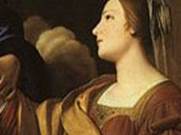THE ORDER OF VIRGINS
From the beginning of the Church there were virgins who wished to consecrate their virginity to Christ and to the service of the Church. They were accepted to the life of virginity by a bishop who consecrated them publicly during a special ceremony.
Since the eighth century, it became clear that the consecrated virgins preferred to live a community life; so the number of those who remained in the world diminished but never had completely disappeared.
The most ancient consecration rite in the Church dates back to the year 353A.C. It was the rite used by the Popes in Rome. The new rite was promoted by the Decree of the Congregation for Divine Worship and the Discipline of the Sacraments on May 31, 1970 and made possible for women living in the world to receive consecration. This rite “is one of the most precious treasures in the Roman liturgy” (Decree from May 31st, 1970).
The order of virgins is laid down in the Code of Canon Law in the article 604. In this Canon it is characterized as “the order of virgins, who, committed to the holy plan of following Christ more closely, are consecrated to God by the diocesan bishop according to the approved liturgical rite, are mystically espoused to Christ, the Son of God, and are dedicated to the service of the Church”.
The Ordo Virginum has no other founder than the Church, which took inspiration from the life of the Spouse himself our Lord Jesus Christ and from the life of the Virgin Mary.
As distinct of the religious orders and secular institutes Ordo Virginum has no firm rules or structures of a common life but “virgins can be associated together to fulfill their pledge more faithfully and to assist each other to serve the Church in a way that befits their state” (Art. 604, B). They live in the world without “being from the world”.
The consecrated virgin is a woman consecrated to God as a bride of Christ in the service of the Church. A diocesan bishop receives her solemn vows and consecrates her to God during a solemn public liturgical rite. She is:
VIRGIN:She is a virgin because the Church is virgin. Women who received consecration bound themselves “by an irrevocable decision” confirmed by the liturgical rite “to live a life of virginity and to follow Christ” in the radicality of the gospel.
SPOUSE: She is a spouse because Christ has loved his Church as his spouse. Vocation of consecrated virgin is to be a spouse of Christ. As a sign of her engagement she receives a ring, (it is possible also to receive a veil or another signs of consecration). Consecrated virgin strive with her whole existence for an effort to be “a special eschatological image of the Heavenly Bride – the Church and of the life to come. She understand any situation as an opportunity to bear witnesses about God’s union with His people.
MOTHER: She is a mother because the Church is mother. As the Holy Virgin the consecrated virgin also strives to fulfill Father’s will and in that way she has opened herself for the spiritual fruitfulness. She has became – in many forms – a spiritual mother of many children of God.
If you would like to know more you can read:
Verġni għal Kristu
L-Ordo Virginum ħajja kkonsagrata dejjem ġdida.
Mons. Selim Sayegh, CAK 2006.
Contact person for Malta:
Ms Dalia Kandalaft OV
Mob: +356 99885856
Facebook: Ordo Virginum Malta





